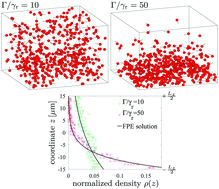Guided run-and-tumble active particles: wall accumulation and preferential deposition†
Abstract
Bacterial biofilms cost an enormous amount of resources in the health, medical, and industrial sectors. To understand early biofilm formation, beginning from planktonic states of active suspensions (such as Escherichia coli) to micro-colonization, it is vital to study the mechanics of cell accumulation near surfaces and subsequent deposition. Variability in bacterial motion strategies and the presence of taxis fields make the problem even more multifaceted. In this study, analytical expressions for the density and angular distributions, mean orientation, and deposition rates in such bacterial suspensions are derived, with and without the effects of external guiding or taxis fields. The derived results are closely verified by simulations of confined active particles using run-and-tumble statistics from multiple past experiments and utilizing a preferential sticking probability model for deposition. The behavioral changes in cell running strategies are modeled by varying the run-time distribution from an exponential to a heavy-tailed one. It is found that the deposition rates can be altered significantly by a guiding torque but are less affected by a change in the cell running behavior. However, both the mechanisms alter the pair correlation function of the deposited structures. The factor behind the changes in the architecture of deposited biomass under a torque generating guiding field turns out to be an asymmetrical rotational drift of planktonic cells, which can be an important physical mechanism behind the organization in confined active particle suspensions.



 Please wait while we load your content...
Please wait while we load your content...